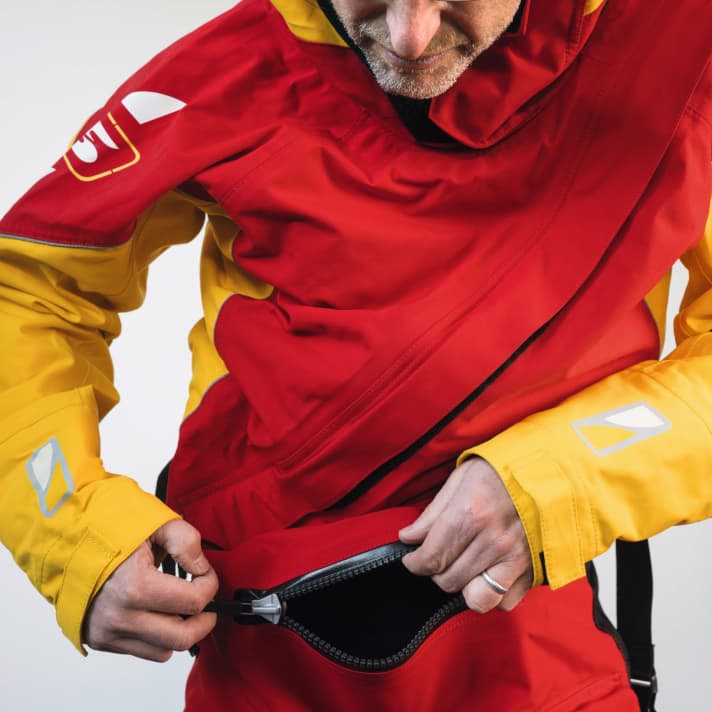Market overview: Survival suits: Which ones are available, what to look out for
Nils Theurer
· 19.07.2022

It happened on a stormy night off Mallorca: the mast broke on a new Mini 650 and Melwin Fink and his co-sailor Marc Menzenbach had to abandon their boat, which was no longer manageable without a rig and engine (see also YACHT 10/2022). The young sailors had to jump into the 15-degree water to be rescued by a Majorcan sea rescue helicopter.
Fink himself jumped in his oilskin and gave the only survival suit on board to the seasick crew member Menzenbach. This was a TPS suit from Guy Cotten. A product that is particularly popular among French regatta sailors, whose origins lie in the SOLAS certification (International Convention for the Safety of the Life at Sea), but which was never certified. Not even according to the similar European standard (see box below).
This is undoubtedly confusing, but the basic physical reasoning is the same everywhere and quite simple: ordinary oilskins keep you dry and warm thanks to the insulating air underneath, while water-repellent clothing hardly warms you at all when worn next to the skin. A knitted fleece fabric therefore represents a good ratio of surface weight, bulkiness and thus insulating effect. The thermal conductivity of water is 25 times higher than that of air. If trapped air is replaced by water after going overboard, there is a risk of hypothermia.
We took a close look at these eight survival suits:
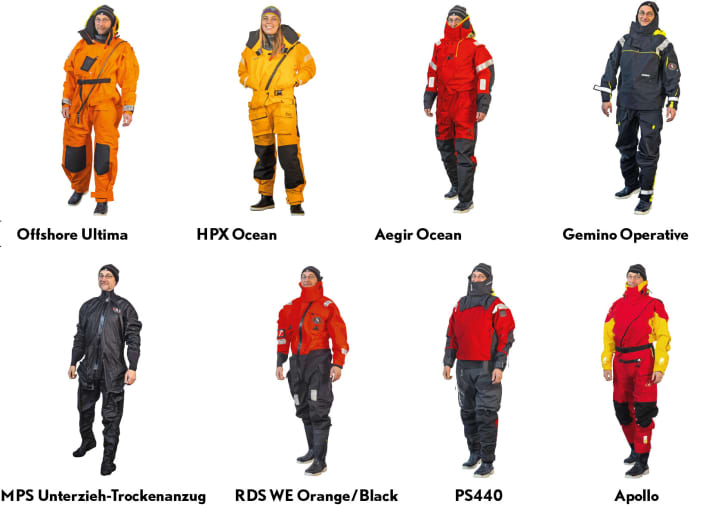
Melwin Fink tells us: "I didn't mind the cold water for the few minutes until I was taken down, but in the helicopter Marc was able to take off his suit and was dry underneath, whereas I was wet and really frozen."
In a conventional drysuit, the insulation layer is compressed, especially on the underside, but this layer of air remains intact. This is why the inflation valves, which are built into the suits made by Musto and Guy Cotten, for example, are useful; the areas in which the insulation only covers the material thickness of the undergarment worn become smaller when inflated.
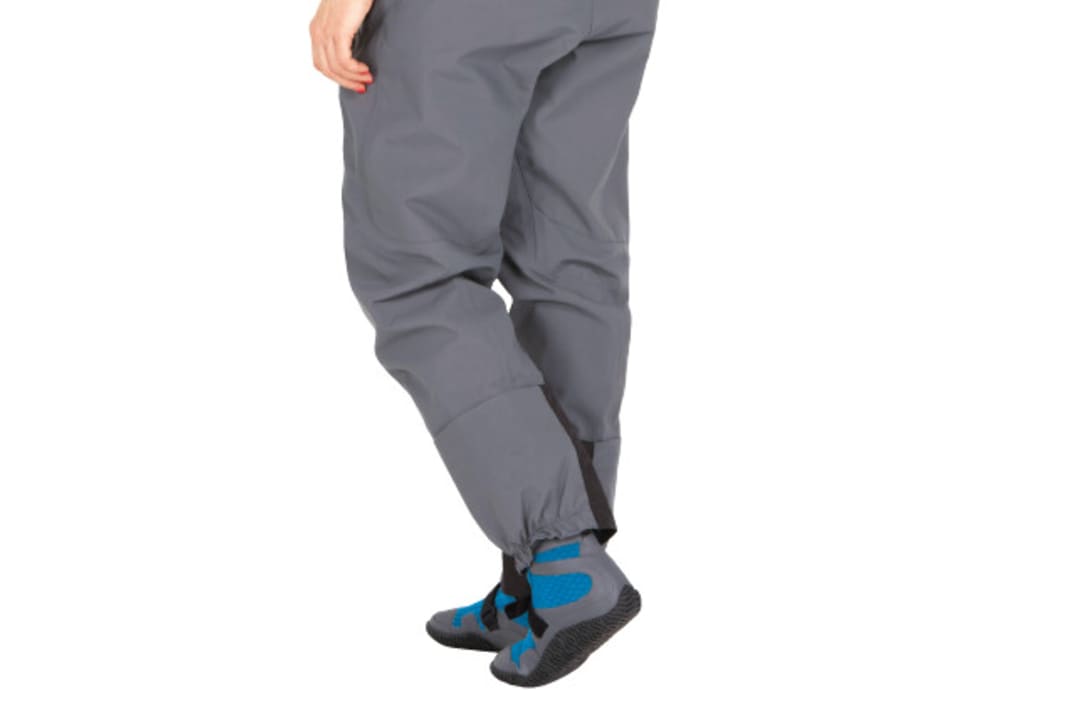





Divers sometimes fill their suit with argon, which is carried anyway to reach greater depths. Its thermal conductivity is even lower - a trick for keeping warm that is not available to sailors.
However, a lot of insulation also means possible heat build-up on deck. In spring, the water is so cold that a lot of underwear is recommended. But the sun sometimes heats up the suit and wearer too much. When the season is extended in autumn, the situation is sometimes simpler: it is already very cold on board, so a lot of underwear is advisable anyway, while the water temperature only drops slowly towards winter - so there is a trade-off. The regulations for regattas with the small Mini 650 single-handed racers stipulate a survival suit for long passages, the performance of which roughly corresponds to protection categories C to D (see below). Everyone has this on board, and many also wear a - non-standardised - offshore drysuit, which also protects against hypothermia when going overboard, provided there is sufficient underwear. We mainly tried out such suits, see table. There are already two overalls on board, Tapio Lehtinen has three (see interview). Too expensive?
Lina Rixgens, mini-650 skipper: "I wear my Musto HPX ocean suit when there are waves in winds of 25 knots or more, sometimes for several days." She also has a neoprene drysuit on board, but swears by her Gore-Tex model. "The dry suit is worth its weight in gold in my eyes. Especially when working on the foredeck, where a wave can sometimes shoot into your boots, you stay dry thanks to the booties; the waterproof cuffs on the neck and arms prevent water from getting in there too." However, the cuffs also harbour problems: "An option with a neoprene cuff on the neck could improve comfort even further over several days. Especially with salt water, the latex cuff can cause chafing on the skin after several days. The neck is already well protected from water thanks to the high collar and hood. A neoprene cuff could improve comfort." A human problem area: "I go to the bucket as normal, it works with a bit of practice" - the female skippers we interviewed prefer this to a solution with a urine funnel from outdoor supplies; with Peezip, urinating is possible without taking off the suit.
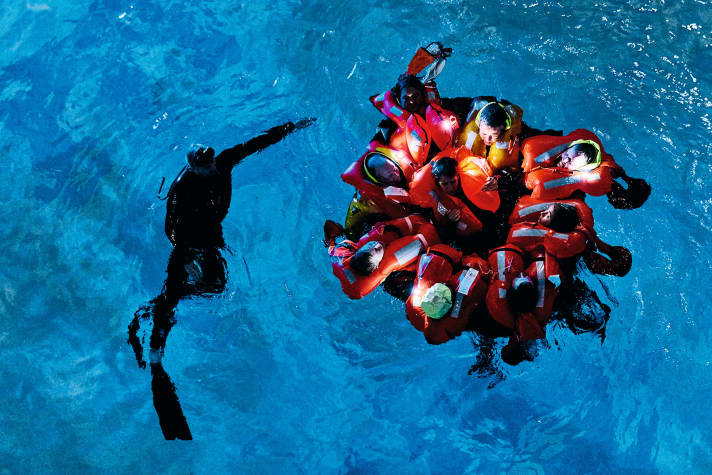
Daniel Ackermann, who built a 5.60 metre TriRaid 560S from Munich-based builder Klaus Metz and took part in the Race to Alaska with it, reports: "With the open cockpit, the boat sails very wet. I needed a dry suit for the race and wore it almost the whole time."
Outfitters rarely stock the expensive suits; different models and sizes can be tried out during heavy weather and survival training, for example with the provider Sailpartner. Expertise is available for around 300 to 600 euros, including swimming with overalls.
We requested and tested eight suits. Many of the details are not included in the manufacturers' descriptions, and comparability between the manufacturers is often not possible.
All models except for the Ursuit RDS suit are not tested in accordance with the European standard. The very complex procedure is only worthwhile for the larger sales figures in the commercial sector, for rescue or fishing. Nevertheless, they are better than no suit at all. "Safety was of course the main point," says Jan Leon, sailing instructor at Hanseatische Yachtschule Glücksburg, which is why he opted for an Ursuit Gemino suit: "I can put in knee pads and buttock pads, it is in no way inferior to a normal oilskin suit, and the price is also similar." He reports from friends with MPS undersuits: "They chose it mainly for cost reasons, and they all want to buy the Gemino next." By the way, if you want to save money: many suits are offered second-hand on fierceturtle.co.uk.
Does such equipment replace a life raft? The dry suit already keeps you warmer when working on board, which promises safety in manoeuvres anyway. When manoeuvring overboard, the advantages depend on the underwear. If you are planning to submerge, for example to lower or sink the yacht, there is usually an opportunity to put on sufficient underwear beforehand. In its records, the German Maritime Search and Rescue Service (DGzRS) found no case of a sailor wearing a survival suit. However, they did find a few cases of crew members suffering from hypothermia; all of them would have been able to continue sailing for longer if they had been wearing the protective clothing.
Melwin Fink, who likes to combine oilskin trousers and a tuxedo in everyday life on board, also told us: "When we're travelling in pairs again, there will be two survival suits on board."
How survival suits are tested
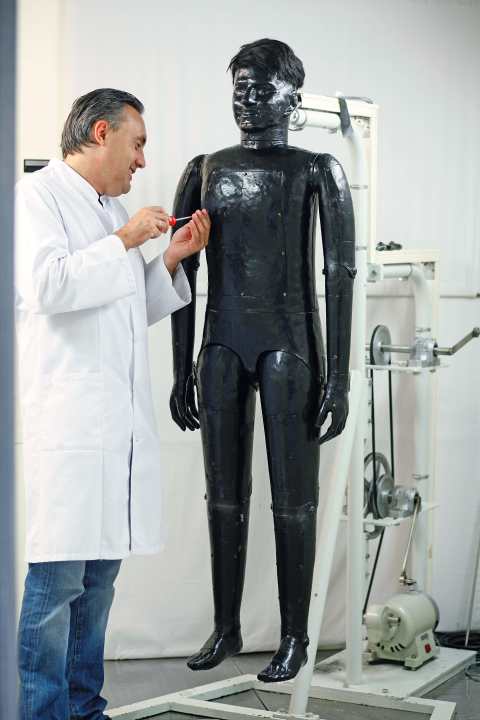
Euronorm 15027 certifies survival suits - in addition to the similar SOLAS regulations. In the ergonomics test, six test subjects jump into the water from four and a half metres, swim 350 metres and climb a platform. Leaks are also detected by weighing them out. For the thermal test, the test subjects' skin temperature is measured at 16 test points and their core body temperature is measured rectally. The procedure exposes the test subjects to the risk of hypothermia, which is incompatible with local ethical rules. This is why the Hohenstein Laboratories in Germany test with "Charlie", a copper manikin (above). "Using separate circuits, it takes on the human body and skin temperature and measures the electrical power required to maintain the temperature," says Alina Bartels from the testing institute, explaining the function. For "A certification", the core body temperature must not drop by more than 2 degrees for 6 hours in 2 degree cold water; in the weakest category D, the test only lasts for 2 hours at a water temperature of 10 degrees. For categories C and D, standard underwear consisting of underwear and two woollen jumpers is often sufficient. Higher categories require thicker underwear. However, the high insulation requirement in the water harbours the risk of heat build-up when worn above water. So it's a trade-off, especially for active yacht crews.
Which material is the best?
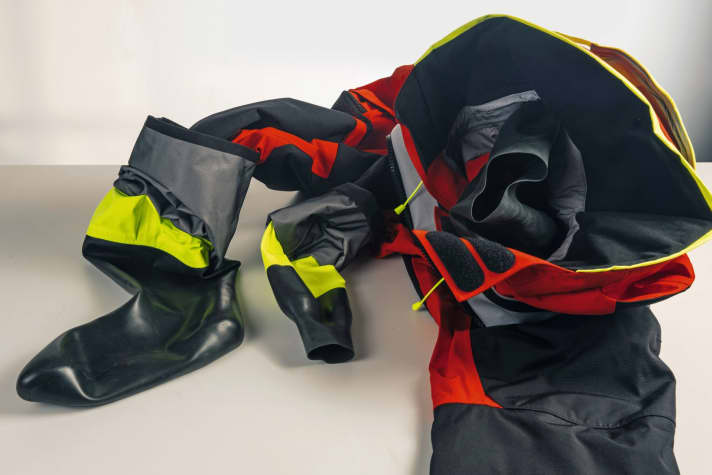
With the exception of the Helly Hansen suit with its somewhat more difficult to put on latex booties (photo), booties made from the suit fabric are standard. Several layers of socks underneath can also keep your feet warm, but this requires larger boots. Significantly cheaper ordinary ones made of non-water vapour-permeable material are usually sufficient in cold conditions (YACHT 22/2016 test). The Slovenian Igor Stropnik sailed around the North Cape in a fam dinghy, wearing only leisure sandals over the padded booties, which worked. Latex arm sleeves are thicker than neoprene sleeves, but many people prefer the softer neoprene for the more sensitive neck; the high collar and hood protect the sleeve so that the lower waterproofness is hardly noticeable. Diving shops or Dryfashion, manufacturers of dinghy drysuits, offer such conversions (70 euros). The vulnerable latex seals are also replaced there (55 euros). The same applies to zips, the heavy-duty metal ones are considered more solid, whereas the lighter plastic models are often fitted with cover strips. Michael Schnell, responsible for Musto products at Frisch, says: "The suits are used very often in long-distance regattas, and the zips are always the weakest point. That's why we have the more robust metal model, which is also more pressure-tight."
Eight survival suits in detail
Offshore Ultima
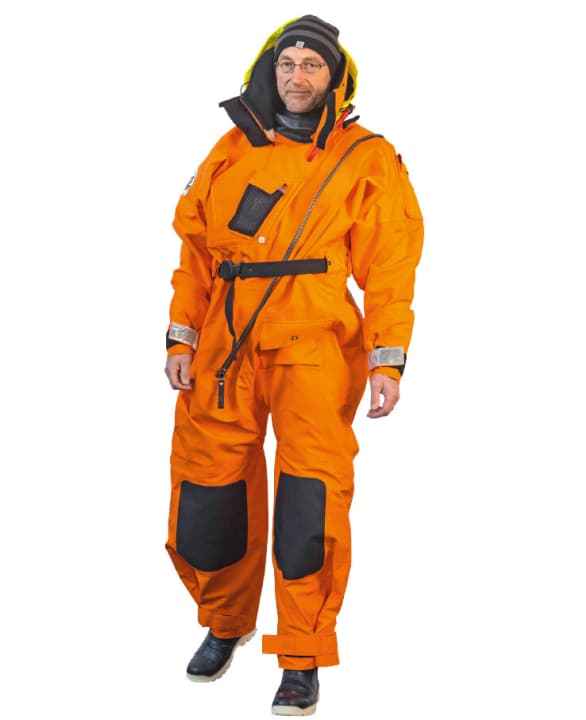
- Model Offshore Ultima
- Manufacturer Guy Cotten, www.guycotten.com
- Price Will be reissued
- Weight 3,187 g (XXL)
- FitVery "baggy" in XXL
- Suit material Dremtech +
- Dressing and undressing, strapsLike dinghy drysuit, straps with clasp to prevent slipping
- Zip: Gradient / Material / Manufacturer Diagonal to the moulding / metal / Dynat
- On-board toilet No Peezip, but main zip up to the thigh
- Cuff neck / arm / booties / double trouser legs Latex / latex / laminate / wider than necessary to mid-thigh
- Hood / collar / storm flap Can be fastened to the collar with press studs. Heavy oilskin material, V-shaped adjustment / very high collar, soft fleece lining / can be folded to the side with Velcro
- Reinforcements Highly slip-resistant trims on the knees and seat
- Bags Upper body/thigh hand warmer pockets with fleece, mesh pocket / flap pocket
- Special features Belt with buckle can be opened and fixed at the side with a press stud, heavy and robust, valve, secured with rubber
- Conclusion Particularly durable, heaviest suit in the test, with valve
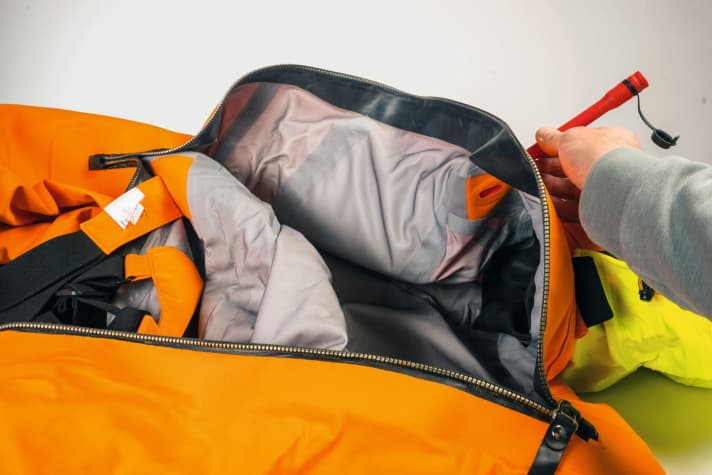
HPX Ocean
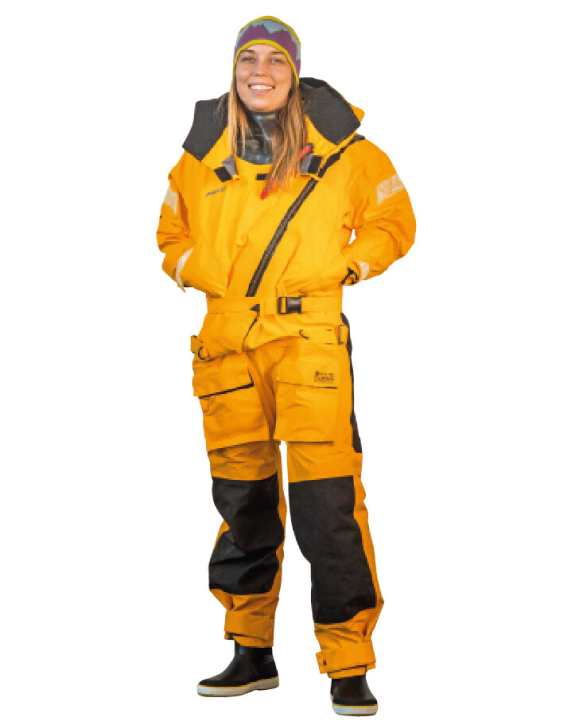
- Model HPX Ocean
- Manufacturer Musto, www.musto-shop.de
- Price 1 .595,00 €
- Weight2,021 g (S)
- FitVery good
- MaterialGore-Tex Ocean suit
- Dressing and undressing, straps Like dinghy drysuit, straps divide to prevent slipping only at the neck
- Zip: Gradient / Material / Manufacturer Diagonal, slider protected by Velcro flap / metal / YKK
- On-board toiletNo Peezip, due to main zip up to the groin
- Cuff neck / arm / booties / double trouser legs Latex / latex / laminate / up to just above the knee
- Hood / collar / storm flap Softly lined on the forehead, V-shaped head adjustment, cord ends secured, cord stoppers fixed / very high, good dimensioning / particularly high, can be folded to the side with Velcro
- ReinforcementsRoughened nylon on elbows, knees and buttocks
- BagsUpper body/thigh hand warmer pockets with fleece / flap pocket
- Special featuresVelcro fastening for multitool, waist belt with buckle, valve, secured with rubber
- ConclusionModel with valve widely used in ocean racing
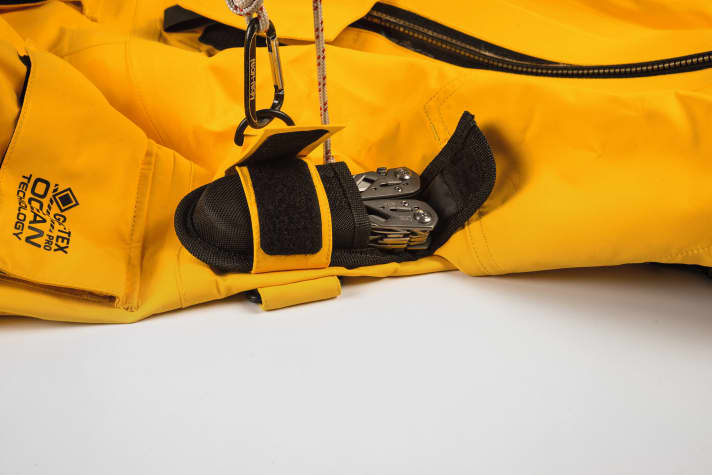
Aegir Ocean
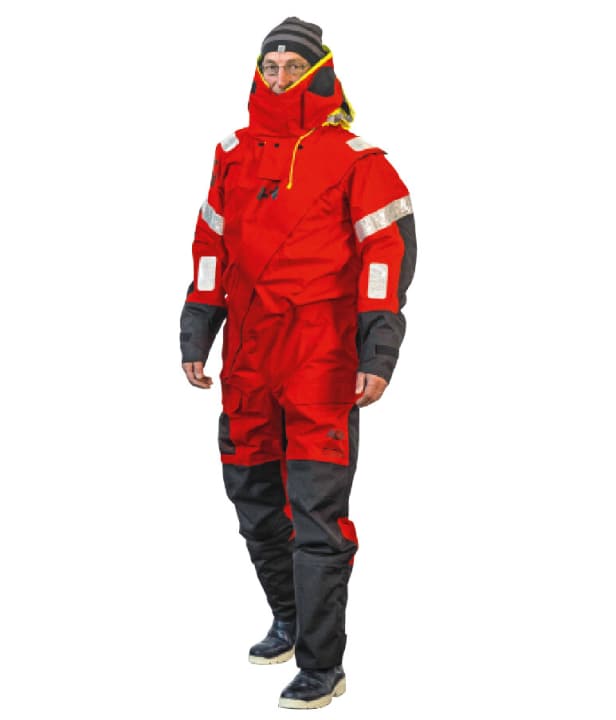
- Model Aegir Ocean
- ManufacturerHelly Hansen, www.hellyhansen.com
- Price1 .800,00 €
- Weight2,470 g (L)
- FitVery good
- Suit material Helly-Tech
- Dressing and undressing, strapsLike dinghy drysuit, cumbersome latex booties, red and green straps
- Zip: Gradient / Material / Manufacturer Diagonal, covered throughout with Velcro flap / plastic / YKK
- On-board toiletNo Peezip, but main zip up to the thigh
- Cuff neck / arm / booties / double trouser legs Latex / Latex / Latex / up to the knee
- Hood / collar / storm flap Soft hem, window, cord ends secured, cord stoppers fixed / very good sizing, can be buttoned to the side with press studs / pre-shaped, soft fleece trim, can be folded to the side with Velcro
- ReinforcementsRoughened nylon on elbows, knees, buttocks, arm seams
- Pockets upper body/thighs none / pocket with flap, pocket with mesh and bellows
- Special featuresExtra large mesh pocket, very functional face protection
- ConclusionSophisticated ocean-going suit with excellent face protection
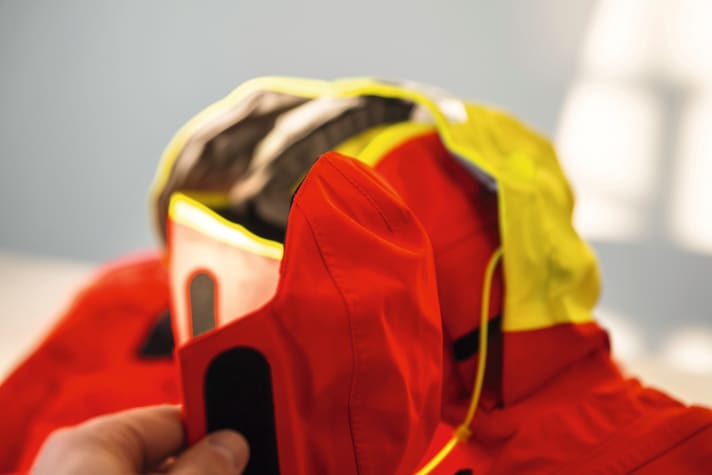
Gemino Operative
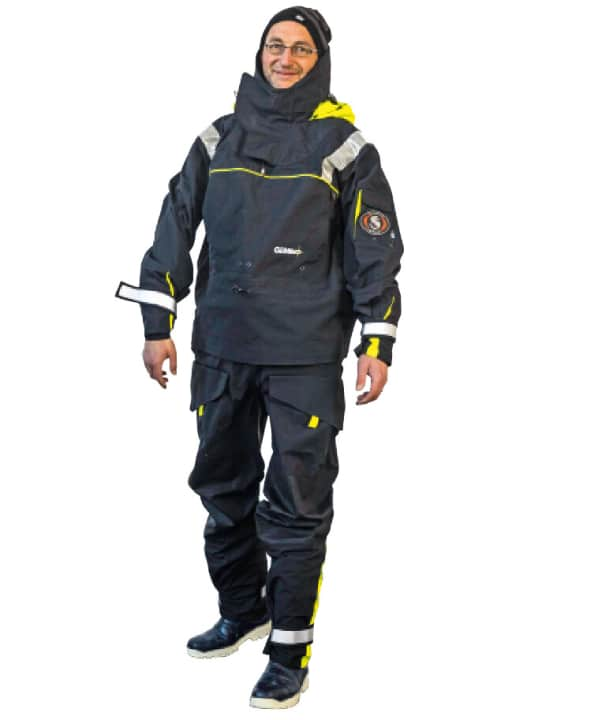
- Gemino Operative model
- ManufacturerUrsuit, www.ursuit.com
- Price1 .825,00 €
- Weight2,484 g (XL)
- FitVery good
- Suit material 4-Tex, also available in red
- Dressing and undressing, straps Slightly longer; wide, non-slip straps lead to the front
- Zip: Gradient / Material / Manufacturer Diagonal to the moulding / metal / Dynat
- On-board toiletSeated toilet use possible without undressing
- Cuff neck / arm / booties / double trouser legs Neoprene / neoprene / laminate / over the knee
- Hood / collar / storm flap Very easy to adjust, cord ends secured, cord stoppers fixed / very high / rather low at the neck, can be rolled to the side with Velcro
- ReinforcementsExtra non-slip rubber on the seat and knees
- Pockets upper body/thighs Unlined kangaroo pocket with zip without lining / 2 flap pockets
- Special featuresSpecial toilet solution, neoprene neck gaiter concealed on the outside for folding inwards
- ConclusionSpecial all-round zip allows users to go to the toilet sitting down
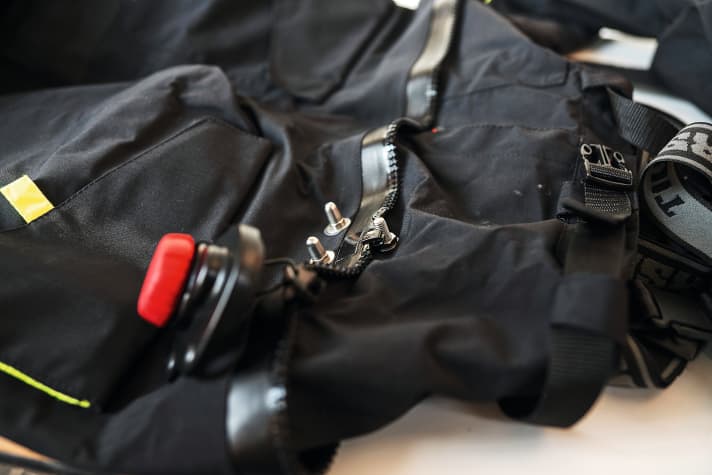
MPS undersuit drysuit
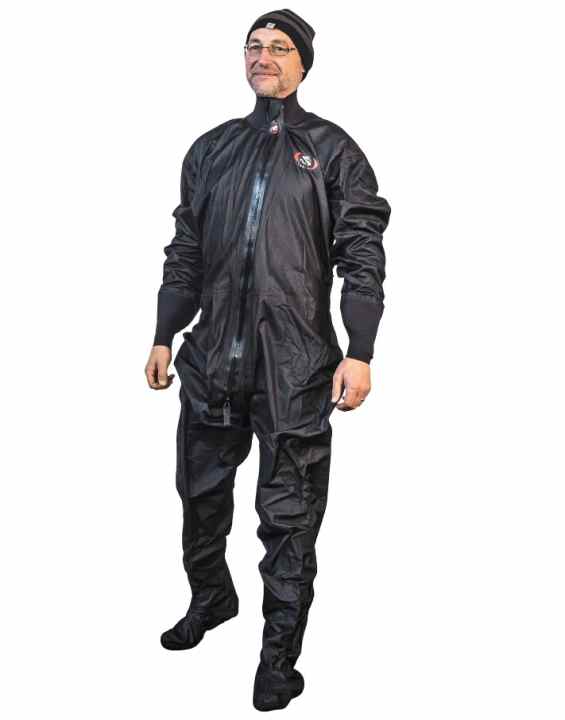
- Model MPS undersuit drysuit
- ManufacturerUrsuit, www.ursuit.com
- Price780,00 €
- Weight816 g (XL)
- FitVery good, conceptually slim
- Suit material Gore-Tex
- Dressing and undressing, straps Simple design, optimum gliding surface, elasticated waist only, no straps
- Zip: Gradient / Material / Manufacturer Diagonal to the neck (less tight) / plastic / YKK
- On-board toiletSuit itself with 2-way zip, but oilskin over it
- Cuff neck / arm / booties / double trouser legs Neoprene / neoprene / laminate / none
- Hood / collar / storm flap Without hood, hood with oilskin worn over it selectable / no collar / no storm flap
- ReinforcementsNone, oilskin worn over it protects on deck
- Pockets upper body/thighs No pockets due to concept
- Special featuresParticularly soft material, glides very well when putting on oilskins and boots
- ConclusionUniversal, lightweight, inexpensive undergarment, also protects against condensation when worn in the cabin
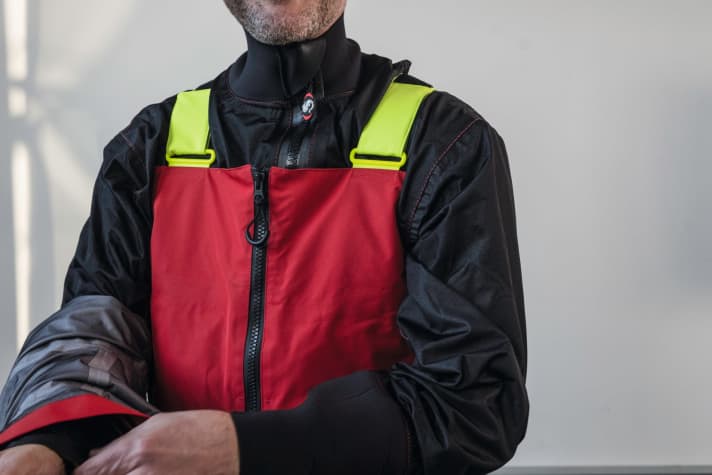
RDS WE Orange/Black
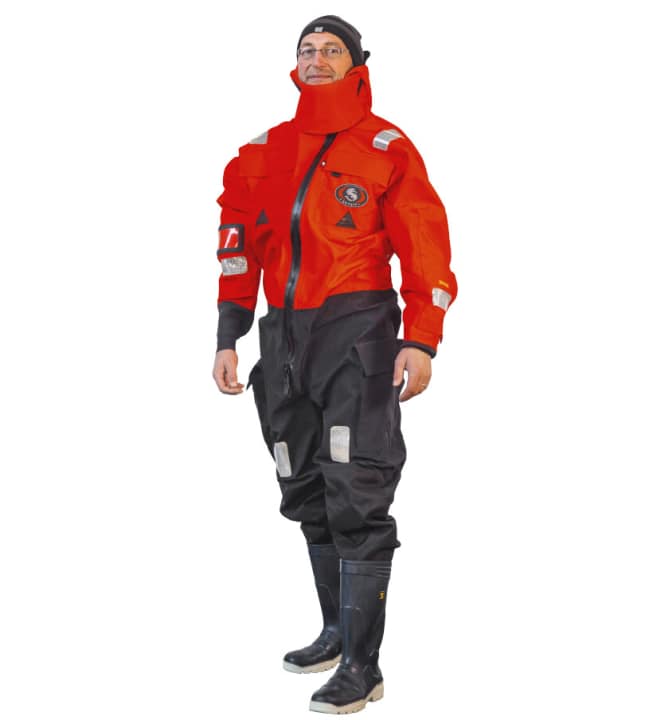
- Model RDS WE Orange/Black
- ManufacturerUrsuit, www.ursuit.com
- Price1 .485,00 €
- Weight2,314 g (XL)
- FitGood, no straps
- Suit material Gore-Tex
- Dressing and undressing, strapsSimple design, elasticated waist only, no straps
- Zip: Gradient / Material / Manufacturer Diagonal to the neck (less tight) / plastic / YKK
- On-board toilet2-way zip
- Cuff neck / arm / booties / double trouser legs Neoprene / neoprene / laminate / none
- Hood / collar / storm flap Small neoprene shield, only hood cord without adjustment to head shape / hood cut, no separate collar / only up to lower edge of chin
- ReinforcementsRoughened nylon on buttocks and knees
- Pockets upper body/thighsTwo breast pockets with whistle, buddy line, arm pockets with gloves / two with bonnet
- Special featuresAdditional neoprene hood and very good neoprene gloves are included and already stowed in pockets
- ConclusionParticularly easy to put on suit with minimal chin protection, with undergarment standardised category D

PS 440
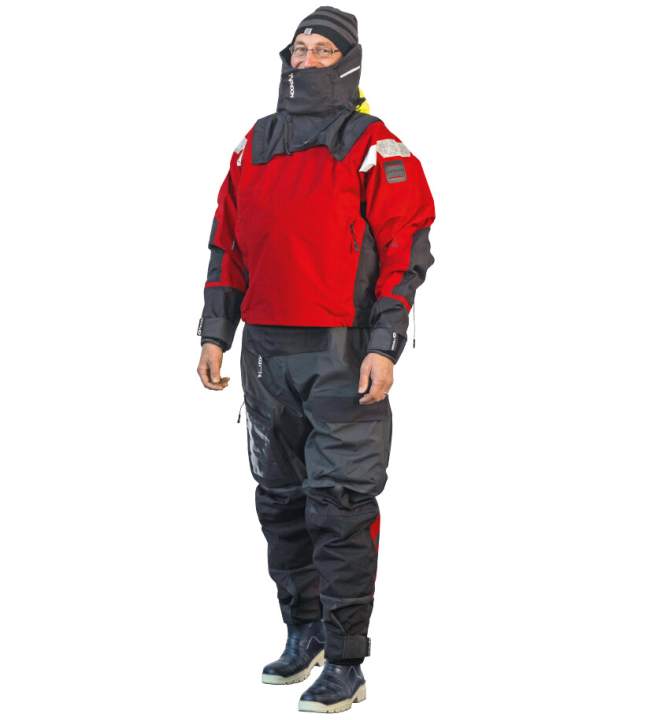
- Model PS440
- ManufacturerTyphoon (GB), www.typhoon-int.co.uk
- Price1 .299,00 €
- Weight2,692 g (XL)
- FitVery good, zip hardly disturbs
- Suit material Without further designation
- Dressing and undressing, straps Opening requires practice, strap on the slider difficult to grip, very wide and soft straps
- Zip: Gradient / Material / Manufacturer From the breastbone once around the back, covered by upper part / plastic / YKK
- On-board toiletPeezip behind flap with ribbon instead of toggle
- Cuff neck / arm / booties / double trouser legs Neoprene / neoprene / laminate / over the knee
- Hood / collar / storm flap Cord ends with extra-long tunnel, cord stoppers fixed / high, can be detached over the shoulders with two zips, low-adhesion Velcro fastener / no storm flap
- ReinforcementsRoughened nylon on knees, buttocks, elbows and sleeve hems
- Pockets upper body/thighs Unlined kangaroo pocket with zip / one with window, one with bellows
- Special featuresElasticated sleeve hem for easy removal, neoprene on the leg hem to prevent it slipping up, key pouch on the strap
- ConclusionUniversal suit with special zip guide thanks to detachable collar
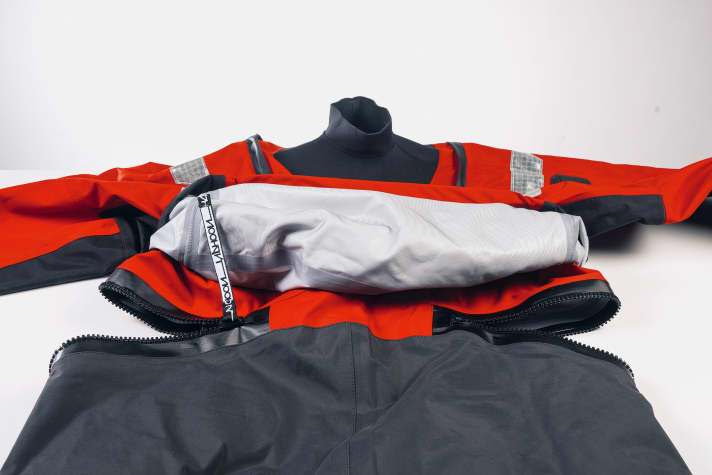
Apollo

- Apollo model
- ManufacturerSandiline, www.sandiline.com
- Price820,00 €
- Weight1,028 g (XL)
- FitVery good, slim cut
- Suit material Toyota Gelantos
- Dressing and undressing, straps Like dinghy dry suit, carrier with welded-on suspension for good load transfer
- Zip: Gradient / Material / ManufacturerDiagonal, covered throughout with Velcro flap / plastic / Tizip
- On-board toiletPeezip with toggle without cover
- Cuff neck / arm / booties / double trouser legs Neoprene / latex / laminate / only up to mid-lower leg
- Hood / collar / storm flap Cord ends secured, cord stoppers fixed, height adjustable via Velcro / high at the neck, less at the front, few adjustment options, very soft fleece lining / no storm flap
- ReinforcementsLightweight, roughened nylon on the back and knees
- Pockets upper body/thighs None / one with bellows
- Special featuresSomewhat short double trouser legs, but functional Peezip, sensible combination of latex and neoprene cuffs
- ConclusionSporty cut, lightweight, comparatively inexpensive suit with few shortcomings
